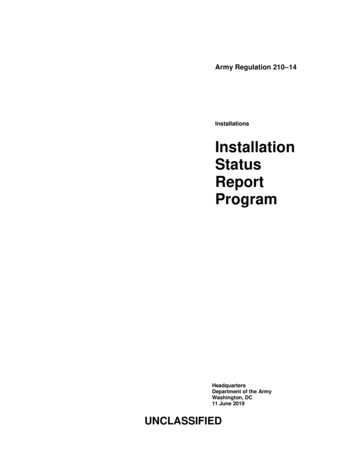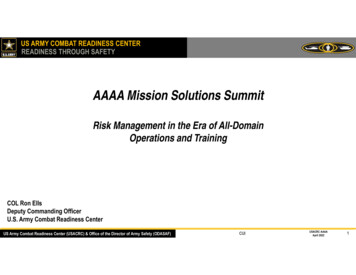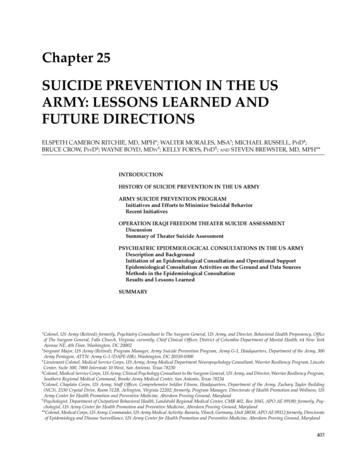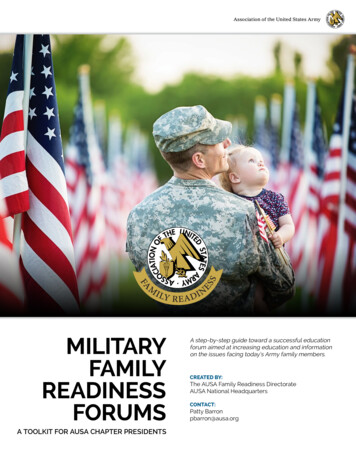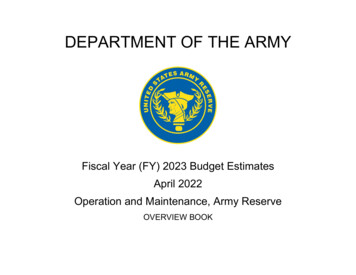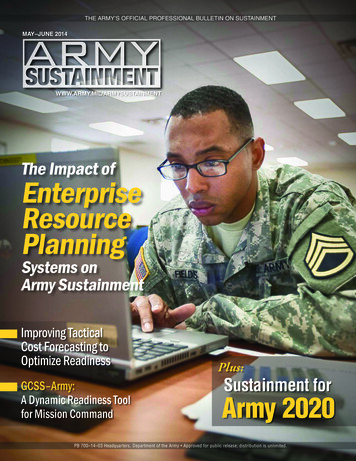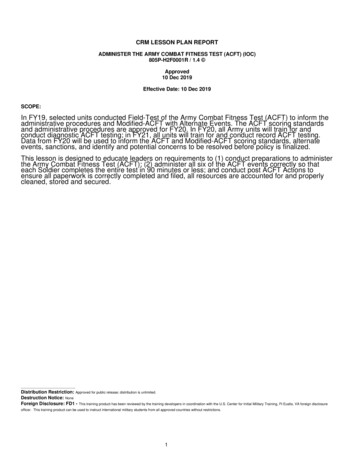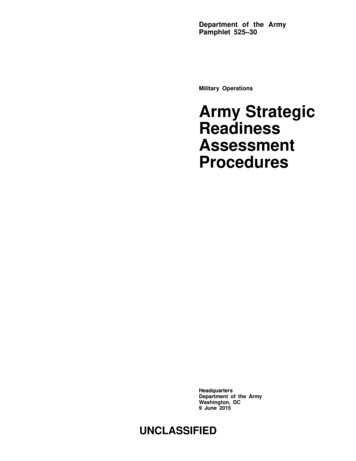
Transcription
Department of the ArmyPamphlet 525–30Military OperationsArmy Department of the ArmyWashington, DC9 June 2015UNCLASSIFIED
SUMMARYDA PAM 525–30Army Strategic Readiness Assessment ProceduresThis new publication, dated 9 June 2015 -oImplements strategic readiness assessment procedures and processes per AR525-30 (throughout).oImplements extensive information regarding Army strategic readiness and howit is reported, prepared, reviewed, and submitted (throughout).
Department of the ArmyPamphlet 525–30HeadquartersDepartment of the ArmyWashington, DC9 June 2015Military OperationsArmy Strategic Readiness Assessment ProceduresHistory. This publication is a newDepartment of the Army pamphlet.Summary. This pamphlet explains anddocuments the basic Army strategic readiness assessment processes and generalreporting procedures used in determining,analyzing, assessing, and reporting ArmyStrategic Readiness in accordance withthe three Joint Staff Criteria (Joint Capability Assessments, Army Plan Assessment, and Readiness Deficiencies) and sixContentsArmy Strategic Readiness Tenets (Manning, Equipping, Sustaining, Training, Installations, and Capacity and Capability).This pamphlet outlines the process for coordinated Army Strategic Readiness Assessment execution within the Departmentof the Army to support Nationalobjectives.include formal review by the activity’ssenior legal officer. All waiver requestswill be endorsed by the commander orsenior leader of the requesting activityand forwarded through their higher headquarters to the policy proponent. Refer toAR 25–30 for specific guidance.Applicability. This pamphlet applies tothe Active Army, the Army NationalGuard/Army National Guard of the UnitedStates, and the U.S. Army Reserve, unlessotherwise stated. Also, it applies to Department of the Army civilians.Suggested improvements. Users areinvited to send comments and suggestedimprovements on DA Form 2028 (Recommended Changes to Publications andBlank Forms) directly to Deputy Chief ofStaff, G–3/5/7 (DAMO–ODR), 400 ArmyPentagon, Washington, DC 20310–0400.Proponent and exception authority.The proponent of this pamphlet is theDeputy Chief of Staff, G–3/5/7. The proponent has the authority to approve exceptions or waivers to this pamphlet thatare consistent with controlling law andregulations. The proponent may delegatethis approval authority, in writing, to adivision chief within the proponentagency or its direct reporting unit or fieldoperating agency, in the grade of colonelor the civilian equivalent. Activities mayrequest a waiver to this pamphlet by providing justification that includes a fullanalysis of the expected benefits and mustDistribution. This publication is available in electronic media only and is intended for command levels A, B, C, D,and E for the Active Army, the ArmyNational Guard/Army National Guard ofthe United States, and the U.S. ArmyReserve.(Listed by paragraph and page number)Chapter 1Introduction, page 1Purpose 1–1, page 1References 1–2, page 1Explanations of abbreviations and terms 1–3, page 1Chapter 2The Army Strategic Readiness Assessment Process, page 1General 2–1, page 1Strategic readiness reporting synchronization 2–2, page 2Army strategic readiness criteria 2–3, page 4Strategic readiness tenet measures 2–4, page 5Strategic indicators 2–5, page 5Strategic levers 2–6, page 5DA PAM 525–30 9 June 2015UNCLASSIFIEDi
Contents—ContinuedReadiness assessment levels 2–7, page 5Chapter 3Determining, Analyzing and Assessing Joint Capability Areas, page 6General 3–1, page 6Joint capability areas 3–2, page 6Assessment of Joint capability areas 3–3, page 8Coordinating instructions 3–4, page 9Chapter 4Determining, Analyzing, and Assessing Army Plans, page 9General 4–1, page 9Joint combat capability assessment-plan assessment 4–2, page 9Time phased force deployment data readiness analysis 4–3, page 10Apportionment table readiness analysis 4–4, page 10Army service component command mission essential task analysis 4–5, page 11Assessment of Army plans 4–6, page 11Coordinating instructions 4–7, page 12Chapter 5Determining, Analyzing, and Assessing Army Readiness Deficiencies, page 12General 5–1, page 12Reporting responsibility 5–2, page 12Measures 5–3, page 12Coordinating instructions 5–4, page 12Chapter 6Determining, Analyzing, and Assessing Manning Data, page 13General 6–1, page 13Reporting responsibility 6–2, page 13Measures 6–3, page 13Strategic Indicators 6–4, page 14Strategic levers 6–5, page 14Chapter 7Determining, Analyzing, and Assessing Equipping Data, page 15General 7–1, page 15Reporting responsibility 7–2, page 15Measures 7–3, page 15Strategic Indicators 7–4, page 16Strategic levers 7–5, page 16Chapter 8Determining, Analyzing, and Assessing Sustaining Data, page 17General 8–1, page 17Reporting responsibility 8–2, page 17Measures 8–3, page 17Strategic Indicators 8–4, page 21Strategic levers 8–5, page 22Chapter 9Determining, Analyzing, and Assessing Training Data, page 22General 9–1, page 22Reporting responsibility. 9–2, page 22Measures 9–3, page 22Strategic Indicators 9–4, page 29iiDA PAM 525–30 9 June 2015
Contents—ContinuedStrategic levers 9–5, page 30Chapter 10Determining, Analyzing, and Assessing Installation Data, page 30General 10–1, page 30Reporting responsibility 10–2, page 30Measures 10–3, page 30Strategic indicators 10–4, page 31Strategic levers 10–5, page 32Chapter 11Determining, Analyzing, and Assessing Capacity and Capability Data, page 32General 11–1, page 32Reporting responsibility 11–2, page 32Measures 11–3, page 33Strategic Indicators 11–4, page 34Strategic levers 11–5, page 34Chapter 12Determining, Analyzing and Predicting Future Strategic Readiness, page 35General 12–1, page 35Unit readiness projections 12–2, page 35Strategic readiness projections 12–3, page 36Chapter 13Strategic Readiness Assessment Group Procedures, page 37General 13–1, page 37Strategic Readiness Assessment Group Overview 13–2, page 37Execution 13–3, page 37Coordinating instructions 13–4, page 37Chapter 14Army Strategic Readiness Assessment Production, page 39General 14–1, page 39Product submission 14–2, page 39Chapter 15Security Classification,General 15–1, page 39Security classification andSecurity Classification andSecurity classification andpage 39declassification of Defense Readiness Reporting-Army Information 15–2, page 39Declassification of Defense Readiness Reporting-Strategic Information 15–3, page 40declassification of the quarterly army strategic readiness assessment 15–4, page 40AppendixesA.References, page 41B.Army Strategic Readiness Assessment Narrative Outline, page 43Table :3–2:4–1:4–2:4–3:4–4:Readiness assessment level definition, page 6Joint Staff readiness metric, page 8Joint capability assessment risk assessment levels, page 9Joint staff military risk level definition, page 9Joint combat capability assessment-plan assessments readiness assessment levels, page 10Time phased deployment data measurement readiness assessment levels, page 10Apportionment table capability measurement readiness assessment levels, page 11DA PAM 525–30 9 June 2015iii
Contents—ContinuedTable 4–5: Army service component command mission essential task measurement readiness assessment levels,page 11Table 5–1: Readiness deficiency assessment levels, page 12Table 6–1: Manning measurement readiness assessment levels, page 13Table 6–2: Personnel readiness (P-level) measures, page 14Table 7–1: Equipping measurement readiness assessment levels, page 15Table 8–1: Sustaining measurement readiness assessment levels, page 17Table 8–2: Maintenance enterprise assessment measures, page 18Table 8–3: Strategic mobility assessment measures, page 19Table 8–4: Munitions assessment measure, page 20Table 8–5: Army prepositioned stocks assessment measures, page 20Table 9–1: Indicators for training tenet readiness assessment levels, page 22Table 9–2: Measures for the operational training indicator, page 23Table 9–3: Measures for the institutional training indicator, page 24Table 9–4: TSS services measures, page 25Table 9–5: TSS services sub-measures, page 25Table 9–6: TSS facilities measures, page 27Table 9–7: TSS facilities sub-measures, page 27Table 9–8: TSS products measures, page 28Table 9–9: TSS products sub-measures, page 28Table 9–10: Training ammunition measures, page 29Table 10–1: Installation measurement readiness assessment levels, page 30Table 11–1: Capacity and capability measurement readiness assessment levels, page 33Table 13–1: Quarterly Army strategic readiness assessment battle rhythm and product submission synchronizationmatrix, page 38Figure ListFigure 2–1: Army strategic readiness assessment process, page 2Figure 2–2: Temporal overview of the strategic readiness update, Army strategic readiness assessment, Joint forcesreadiness review, and quarterly readiness report to Congress, page 3Figure 2–3: Joint Staff and Army criteria used to determine the Army strategic readiness assessment, page 4Figure 11–1: Calculation of capacity and capability, page 32GlossaryivDA PAM 525–30 9 June 2015
Chapter 1Introduction1–1. PurposeThis Department of the Army pamphlet (DA Pam) explains and documents the basic Army strategic readinessassessment (ASRA) processes and general reporting procedures. This process includes determining, analyzing, assessing, and reporting Army strategic readiness in accordance with the three Joint Staff criteria (Joint Capability Areas(JCAs), Army plan assessment, and readiness deficiencies) and six Army strategic readiness tenets (manning, equipping, sustaining, training, installations, and capacity and capability). The ASRA prepares the analysis by criteria, keyindicators, and measures and develops the assessment through the Strategic Readiness Assessment Group (SRAG). TheASRA is then delivered quarterly to the Army’s senior leaders. While this publication explains and documents thebasic processes and general procedures for assessing and analyzing Army strategic readiness, AR 525–30 is theauthoritative publication for Army strategic readiness policy. Selected policy provisions that are established in AR525–30 are replicated in this publication to enhance the utility of this publication to its intended users. However, in theevent that any provisions in this DA Pam conflict with those in AR 525–30, the provisions in AR 525–30 will takeprecedence.1–2. ReferencesRequired and related publications and prescribed and referenced forms are listed in appendix A.1–3. Explanations of abbreviations and termsAbbreviations and special terms used in this pamphlet are explained in the glossary.Chapter 2The Army Strategic Readiness Assessment Process2–1. GeneralThe ASRA Process is a quarterly comprehensive analysis of the Army’s strategic readiness levels across the total forcenecessary to inform the Army’s senior leaders, the Joint Staff, Office of the Secretary of Defense (OSD), and Congresson the status of the Service to meet the demands of the National Military Strategy (NMS). This assessment combinesobjective, quantitative, empirical, qualitative, and subjective strategic measures and indicator assessments to portray aholistic view of current and projected strategic readiness. The ASRA is the Army’s source document to meet readinessreporting requirements of the Joint Force Readiness Review (JFRR) and the Quarterly Readiness Report to Congress(QRRC). It also assists senior leaders in congressional hearing preparation, questions for the record responses, thecomprehensive Joint assessment (CJA), chairman’s risk assessment (CRA), and the Secretary of Defense Risk Mitigation Plan. Figure 2–1 visually depicts the relationship of unit reports, the Army’s strategic readiness tenets (SRTs), andJoint Staff criteria used to develop the ASRA. This chapter provides an overview of the quarterly ASRA process anddescribes how the ASRA contributes to both Joint Staff and OSD readiness assessments provided to key leaders andCongress as mandated by Title 10, United State Code (10 USC).DA PAM 525–30 9 June 20151
Strategic Readiness TenetsCommander’sUnit StatusReport (CUSR)Army Staff(ARSTAF)Army Commands(ACOMs)JointCapabilityArea (JCA)TrainingArmy e 10RequirementsChairmanJoint Chiefs of StaffEquippingCapacity&CapabilityArmy PlanAssesmentsJoint ForceReadinessReview(JFRR)ReadinessAssessmentLevel (RA)GREENLIGHTGREENRA1RA2ASRAYELLOWREDRA3RA4Direct ReportingUnits (DRUs)Army NationalGuard inessReport ConcernsUS Army Reserve(USAR)InstallationINPUTHOLISTIC ANALYSISOUTPUTFigure 2–1. Army strategic readiness assessment process2–2. Strategic readiness reporting synchronizationa. The ASRA process begins with monthly strategic readiness updates (SRUs). The SRU, chaired by Vice Chief ofStaff of the Army (VCSA), provides an overview of the Army’s tactical, operational, and strategic readiness levels.Tactical level readiness is the summation of the monthly commander’s unit status reports (USRs), which is highlightedevery month. Specific operational and strategic level readiness analysis and topics are covered and differ from month tomonth; however, over the span of a quarter, all key strategic readiness criteria are covered. The SRU allows Armysenior leaders to provide clear readiness guidance and facilitate monthly interaction between the Army Staff(ARSTAF), Army commands (ACOMs), and Army service component commands (ASCCs). It is designed to promotean early, shared understanding of the Army’s current and projected readiness status of Army units, resourcing, policy,or employment decisions, risks, and other key guidance factors.b. During the third month of each quarter (DEC, MAR, JUN, and SEP), the Army produces the actual ASRAcomprehensive written report. This report and recommended input to the Joint Force Readiness Review (JFRR) isspecifically briefed to the Army Senior Leaders during the third month of each quarter’s SRU.c. The JFRR is the principal assessment of the Chairman’s Readiness System (CRS) and assesses the ability of theDepartment of Defense (DOD) to execute the NMS per Chairman of the Joint Chiefs of Staff Instruction (CJCSI)3401–01E. The Director of the Joint Staff (DJS) has oversight of the JFRR and is briefed quarterly by the Services,combatant commands (CCMDs), combat support agencies, and Joint directors during the Joint Combat CapabilitiesAssessment Group (JCCAG). The JFRR is based on three assessments. First, analysis of the nine Joint CapabilityAreas (JCAs). Second, it includes an assessment of the readiness of Army units to conduct contingency operations.Third, the JFRR incorporates readiness deficiencies provided by ASCCs, ACOMs, and DRUs. The result is anaggregate readiness assessment (RA) level with two accompanying top concerns. Taken together, this assessmentfulfills the statutory and policy requirements for a Service readiness assessment.2DA PAM 525–30 9 June 2015
d. The Army uses the ASRA and the Joint Staff utilizes the JFRR to inform their submission to the QuarterlyReadiness Report to Congress (QRRC). The QRRC is mandated by Congress under 10 USC 482, quarterly reports, andidentifies readiness deficiencies, key indicators, and other relevant information related to each identified deficiency, andremedial actions to correct them. Army submission topics include logistics, personnel strength, and training.e. The comprehensive joint assessment (CJA) requests comprehensive senior military leader assessments fromService chiefs and combatant commanders relating to their ability to meet 10 USC and Unified Command Planresponsibilities and support the NMS within their area of responsibility or functional area. The ASRA provides theArmy and ASCC input to the six CJA requirements (integrated response, security environment, current operations andhealth of the force, near term military risk assessment, near term risk drivers and mitigation, and implications for thefuture force).f. The chairman’s risk assessment (CRA) provides to Congress the chairman’s assessment of the nature andmagnitude of strategic and military risk in executing the missions called for in the NMS. The CRA provides a holisticassessment of the ability of the Armed Forces to meet strategic requirements in the near-term. The Army uses theASRA to provide input to the CRA.g. The SECDEF Risk Mitigation Plan is a document submitted to Congress that addresses concerns outlined in theCRA. This plan may recommend changes in strategy, development of new operational concepts or capabilities,increases in capacity, or adjustments in force posture or employment.h. Figure 2–2 represents the temporal flow of information, beginning with tactical level USR data, and culminatingin the QRRC. The analysis and assessment provided by this ASRA process synchronizes and feeds all readinessreporting requirements as dictated by policy and statute.MANDATED BY CONGRESS UNDER 10 USC 482 - SECTION 482 - QUARTERLY ��S RISKMITIGATION PLANAUGSEPOCTCOMPREHENSIVE JOINTASSESSMENT (CJA)QRRCQRRCAR 525-30JULNOVDECCHAIRMAN’S RISKASSESSMENT (CRA)QRRCQRRCJOINT COMBATCAPABILITYASSESSMENTGROUP(JCCAG)O-6, 3-Star, DJSJOINT COMBATCAPABILITYASSESSMENTGROUP(JCCAG)O-6, 3-Star, DJSJOINT COMBATCAPABILITYASSESSMENTGROUP(JCCAG)O-6, 3-Star, DJSJOINT COMBATCAPABILITYASSESSMENTGROUP(JCCAG)O-6, 3-Star, sSRUTOPICSAR 220-1DA PAM RSRTsJCAJFRRUSRUSRSRTsJCAJFRRUSRFigure 2–2. Temporal overview of the strategic readiness update, Army strategic readiness assessment, Joint forcesreadiness review, and quarterly readiness report to CongressDA PAM 525–30 9 June 20153
2–3. Army strategic readiness criteriaThe Army uses four strategic readiness criteria to determine the ASRA. In accordance with CJCSI 3401.01E, threecriteria are mandated by the Joint Staff. They are JCA assessments, Army plan assessments, and overall readinessdeficiencies. These three joint staff criteria incorporate the Army’s 10 USC “man, train, equip” responsibilities anddemonstrate how they directly affect joint operations in support of the NMS. Additionally, the ASRA incorporates aspecific Army criterion which consists of six strategic readiness tenet (SRT) assessments. The three Joint Staff andArmy SRT criteria assessments determine the overall ASRA readiness assessment level. All of these criteria arecovered in more detail later in this pamphlet. The Army measures each criterion using a mix of quantitative andqualitative measures. The overall Army strategic readiness assessment level is determined by the lowest rating of thesecriteria.Army ReadinessCriteriaAssessment Assessment (RA)LevelHOW THE ARMYMEASURES EACH CRITERIACRITERIAMANDATORY JOINT STAFF CRITERIAJointCapabilityAreas (JCA)PlanAssessmentRALevelArmy JCA AssessmentsJoint )TPFDDReadinessAnalysisApportionmentTable ReadinessAnalysisASCC MissionEssential RALevelArmy Readiness DeficienciesARMY ipingSustainingTrainingInstallationsEquipmentOn icesCapacity nthe riaAssessmentHealth ofthe ForceCritical onedStocks CapabilityArmy Energyand WaterProgramRA-LevelRA-LevelFigure 2–3. Joint Staff and Army criteria used to determine the Army strategic readiness assessment4DA PAM 525–30 9 June 2015
2–4. Strategic readiness tenet measuresa. SRT measures are based on objective, quantitative, empirical, qualitative, and subjective assessments, or acombination thereof, for each tenet. Aggregation and analysis of various strategic measures reveal emerging strategicreadiness indicators. Assessing measures is the most crucial point of the strategic readiness analysis, because the levelof assessment identifies, with more specificity, the trends, shortfalls, or gaps in particular indicators. Specific measuresmay be selected from a menu of different data points, and preference of one measure over another may change overtime according to variables such as senior leader priorities, evolving geopolitical events, or domestic political conflicts.For example, measuring adverse readiness impacts due to sequestration may only be pertinent during the immediateyears surrounding passage of the Budget Control Act.b. There are a set number of measurable data points for the six strategic readiness tenets that each primary ARSTAFoffice uses to determine its current and projected tenet readiness assessment level. Additional quantitative and/orqualitative measures are also incorporated into the readiness assessment level of each tenet. These measures vary bytenet. While qualitative measures are not as precise as quantitative measures, they are equally relevant when conductinganalysis. The amount of impact qualitative measures will have is determined by the appropriate ARSTAF sectiontasked with submitting their tenet.c. Assessing measures includes not only a current status, but also accounts for risk across the Future Years DefenseProgram (FYDP). This leads to strategic decisionmaking by linking specific strategic shortfalls to the Planning,Programming, Budgeting, and Execution System. This translates the strategic measures from a single point of referenceto a piece of the larger strategic mosaic and enables senior leaders to make strategic decisions.2–5. Strategic indicatorsa. These indicators are those general topics that impact the overall readiness of an individual tenet. They provide theframework for a consistent readiness assessment of each tenet because strategic indicators remain constant over time.These indicators inform decisionmakers that a policy lever needs to be implemented in order to achieve an optimaloutcome.b. Each tenet has its own individual indicators that are combined and measured to provide the readiness assessmentof that particular tenet at the strategic level.2–6. Strategic leversa. These levers are those actions, mitigation measures, or decisions that are implemented to alter the effect of thestrategic indicator in order to improve the readiness assessment of the respective tenet. Strategic levers are specificactions or policies that are defined and measureable. They are determined by deriving the individual functions thataffect the measures within each indicator. These actions must be analyzed until the root cause of a strategic effect canbe pinpointed. The depth of this process will vary with each measure.b. Analyzing and assessing strategic levers should be done by evaluating each individual action for its root impacton a strategic indicator. The goal of this deepest level of analysis is to identify those specific actions that may be takento mitigate the negative effect revealed by the indicator. Once the impacts to readiness are defined, it is possible toassess which actions have such an impact that they are identified as critical capabilities.c. The assessment of risk associated with a particular strategic lever (that is, the ability to support CCMDoperational plans (OPLANs) enables the depiction of potential changes in indicators and outcomes over time. In thismanner, Army senior leaders can see how the implementation of an action on a lever will change their risk over theFYDP.2–7. Readiness assessment levelsa. In order to develop an overall assessment and to ensure common language when assessing the cumulative effectsof readiness assessments across all readiness tenets and criteria, it is essential that assessments are conducted within acommon framework. The Army’s overall strategic assessment will follow the existing Chairman’s Readiness System(CRS), as outlined in CJCSI 3401D. This will allow a seamless transition of the Army assessment to the CRS.b. Table 2–1 identifies the readiness assessments outlined in CJCSI 3401.01E that the Army will use in the overallassessment of each strategic readiness tenet.DA PAM 525–30 9 June 20155
Table 2–1Readiness assessment level definitionReadiness assessment levelDefinitionRA–1Issues and/or shortfalls have negligible impact on readiness andability to execute assigned mission(s) in support of the NMS asdirected in the global employment of the force (GEF) and Joint strategic capabilities plan (JSCP).RA–2Issues and/or shortfalls have limited impact on readiness and abilityto execute assigned mission(s) in support of the NMS as directed inthe GEF and JSCP.RA–3Issues and/or shortfalls have significant impact on readiness andability to execute assigned mission(s) in support of the NMS asdirected in the GEF and JSCP.RA–4Issues and/or shortfalls preclude accomplishment of assignedmission(s) in support of the NMS as directed in the GEF and JSCP.Chapter 3Determining, Analyzing and Assessing Joint Capability Areas3–1. GeneralThe JCA assessments are the first of the three mandatory Joint Staff criteria that inform the ASRA. JCAs arecollections of like DOD capabilities functionally grouped to support capability analysis, strategy development, investment decisionmaking, capability portfolio management, and capabilities-based force development and operationalplanning. The JCAs outlined below are in accordance with the 2015 JCA definitions.3–2. Joint capability areasa. JCA 1 (Force support): The ability to establish, develop, maintain, and manage a mission ready total force.(1) Lead reporting responsibility. Deputy Chief of Staff, G–3/5/7 (DCS, G–3/5/7) (DAMO–ODR).(2) Supporting reporting responsibility.(a) DCS, G–3/5/7 (DAMO–SS).(b) DCS, G–3/5/7 (DAMO–ODO).(c) DCS, G–3/5/7 (DAMO–TR).(d) DCS, G–1.(e) Office of the Surgeon General.(f) U.S. Army Forces Command (FORSCOM).(3) Measures.(a) Global Force Management.(b) Force preparation.(c) Human Capital Management.(d) Health readiness.b. JCA 2 (Battle space awareness). The ability to understand dispositions and intentions, as well as the characteristics and conditions of the operational environment that bear on national and military decisionmaking by leveraging allsources of information to include intelligence, surveillance, reconnaissance, meteorological, and oceanographic.(1) Lead reporting responsibility: DCS, G–2 (DAMI–OP).(2) Supporting reporting responsibility.(a) U.S. Army Intelligence and Security Command (INSCOM).(b) ACOMs.(c) ASCCs.(3) Measures.(a) Planning and direction.(b) Collection.(c) Processing and exploitation.(d) Analysis, prediction and production.(e) BA data dissemination and relay.c. JCA 3 (Force application). The ability to integrate the use of maneuver and engagement in all environments tocreate the effects necessary to achieve mission objectives. The Army as a Service does not execute the forceapplication JCA. The Army assessment is based on ASCC readiness reporting to their CCMD.(1) Lead reporting responsibility: DCS, G–3/5/7 (DAMO–ODR).6DA PAM 525–30 9 June 2015
(2) Supporting reporting responsibility: ASSCs.(3) Measures.(a) Maneuver.(b) Engagement.d. JCA 4 (Logistics). The ability to project and sustain a logistically ready Joint force through the deliberate sharingof national and multi-national resources to effectively support operations, extend operational reach, and provide theJoint force commander the freedom of action necessary to meet objectives.(1) Lead reporting responsibility: DCS, G–4 (DALO–ORR).(2) Supporting reporting responsibility.(a) Assistant Chief of Staff for Installation Management (ACSIM).(b) Chief of Engineers.(c) ACOMs.(d) ASCCs.(e) DRUs.(3) Measures.(a) Deployment and distribution.(b) Supply.(c) Maintenance.(d) Logistics Services.(e) Operational contract support.(f) Engineering.e. JCA 5 (Command and control): The ability to exercise authority and direction by a properly designated commander or decisionmaker over assigned and attached forces and resources in the accomplishment of the mission. TheArmy’s assessment of the command and control JCA reflects Army equities in CCMD exercise of command andcontrol over Army forces. This is not an assessment of the Army’s ability to command and control service retainedforces.(1) Lead reporting responsibility: DCS, G–3/5/7(DAMO–ODR).(2) Supporting reporting responsibility: ASCCs.(3) Measures.(a) Organize.(b) Understand.(c) Planning.(d) Decide.(e) Direct.(f) Monitor.f. JCA 6 (Net-centric): The ability to provide a framework for full human and technical connectivity and interoperability that allows all DOD users and mission partners to share the information they need, when they need it, in aform they can understand and act on with confidence, and that also protects information from those who should nothave it.(1) Lead reporting responsibility: Chief Information Officer/G–6 (SAIS–CBP).(2) Supporting reporting responsibility.(a) DCS, G–2.(b) U.S. Army Cyber Command.(c) 2nd Army.(3) Measures.(a) DOD Information network capabilities.(b) Enterprise services.g. JCA 7 (Protection): The ability to prevent and/or mitigate adverse effects of attacks on personnel (combatant and/or non-combatant) and physical assets of the United States, allies and friends.(1) Lead reporting responsibility: DCS, G–3/5/7 (DAMO–ODP).(2) Supporting reporting responsibility.(a) ACOMs.(b) ASCCs.
Contents—Continued Table 4-5: Army service component command mission essential task measurement readiness assessment levels, page 11 Table 5-1: Readiness deficiency assessment levels, page 12 Table 6-1: Manning measurement readiness assessment levels, page 13 Table 6-2: Personnel readiness (P-level) measures, page 14 Table 7-1: Equipping measurement readiness assessment levels, page 15

